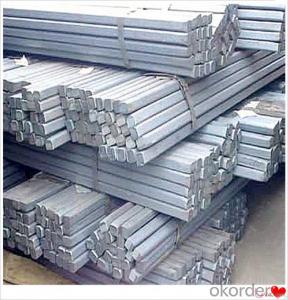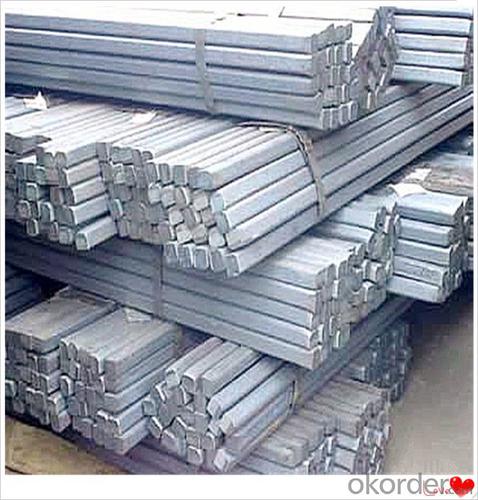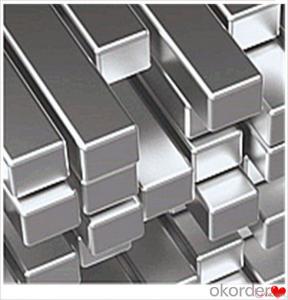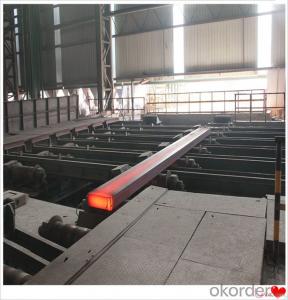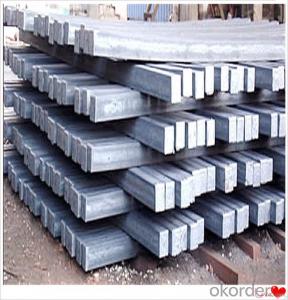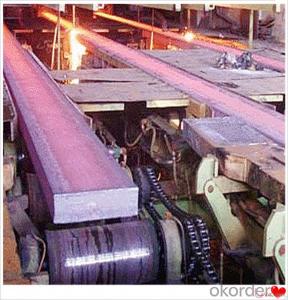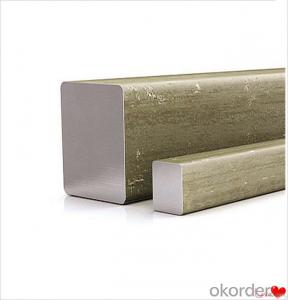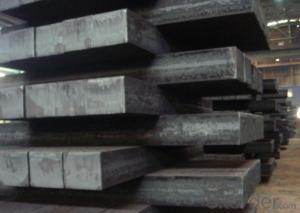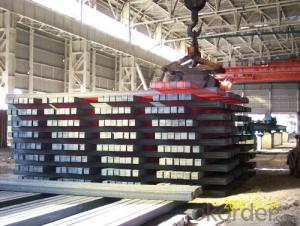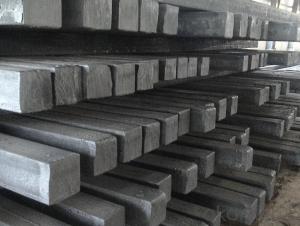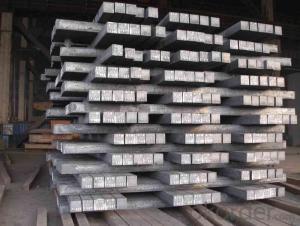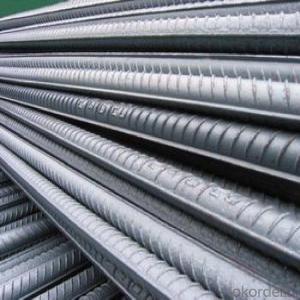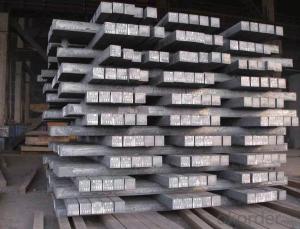Billet Brake Reservoir Q235,Q255,Q275,Q345,3SP,5SP,20MnSi
- Loading Port:
- China main port
- Payment Terms:
- TT OR LC
- Min Order Qty:
- 20 m.t.
- Supply Capability:
- 200000 m.t./month
OKorder Service Pledge
OKorder Financial Service
You Might Also Like
Billet Brake Reservoir Q235,Q255,Q275,Q345,3SP,5SP,20MnSi
Specification
Steel billet(ingot) by cogging or breakdown of semi-finished products, is the raw material of all kinds of steel mill. Billet section of square, round, flat, rectangular and abnormity of several kinds of, mainly related to the shape of rolled products.
CNBM Q235,Q275,Q345,3SP,5SP,20MnSi Billets Steel
Hot Rolled Steel Billets/ Mild Steel Bar/ Billet Steel
Specification (see below)
Standard: GB/JIS/ASTM
Size: 50*50mm-180*180mm
Length: 3-12mtrs or Customised
Steel material: Q235,Q255,Q275,Q345,3SP,5SP,20MnSi
Technique: Hot rolled
FOB Unit Ton Price $250-350 and Usually I will quote you CFR price.
MOQ: Usually 1000-10000MT/size
Shipment:By Container,Bulk Vessel
Packaging Details: bundles with steel strips or as customers's requirements
Delivery time: Usually within 30 days after the deposit/LC
Inspection:Third party inspection before loading.
Technical data
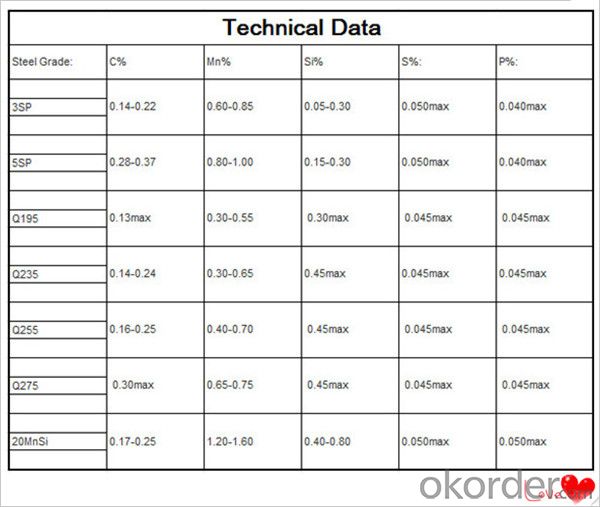
Feature Steel Billet
Rectangular billet continuous casting billet and mainly general carbon steel, low carbon low silicon cold-rolled material, high quality carbon structural steel, high strength low alloy steel, special steel, etc.
The billet is mainly divided into two kinds from the shape:
Slab: cross section width and height of the ratio of the larger, mainly used for rolling plate.
Billet: equal cross section width and height, or a huge difference, mainly used for rolling steel, wire rod. ,
Steel billets have distinct characteristics as compared with already furnished steel bars and products. Billets have a specific grain structure, which enables the metal to be processed more intricately. Steel billets are also known for their malleability and ductility, especially when exposed to varying temperatures during shaping and molding.
Packaging & Shipping
1. Packaging:
1) Small size: in bundles
2)Big size: in bulk
3)in plastic packing or as per customer requirement
2. Delivery time:
1) Normal size: within 7days send from warehouse directly
2) Special size: with 25-30days customer made for you
3. Trade terms:FOB/CFR/CIF
4. Shippment:
1) length:≤5.8m loaded in 20FT Container with 25-27tons
2) length:≤11.8m loaded in 40FT Container with 25-27tons
3) lengnth:≥12m shipped by bulk vessel, FILO terms
Steel Billet Images
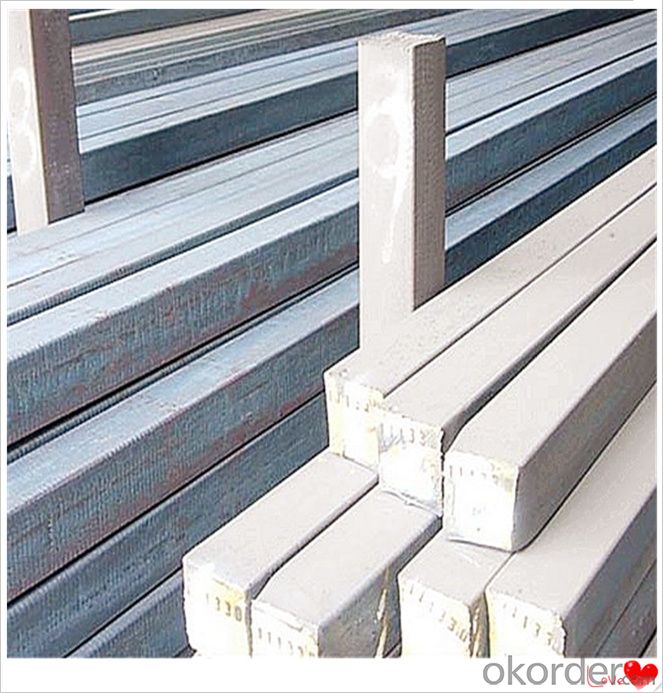
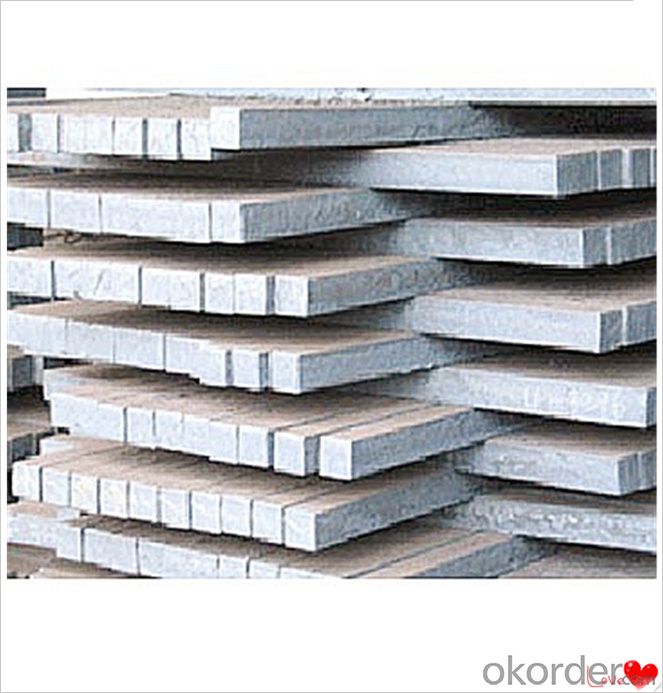
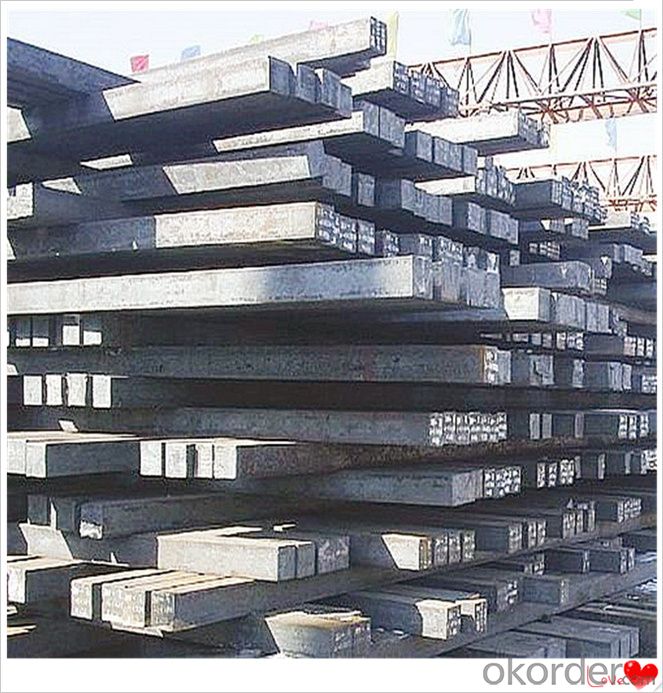
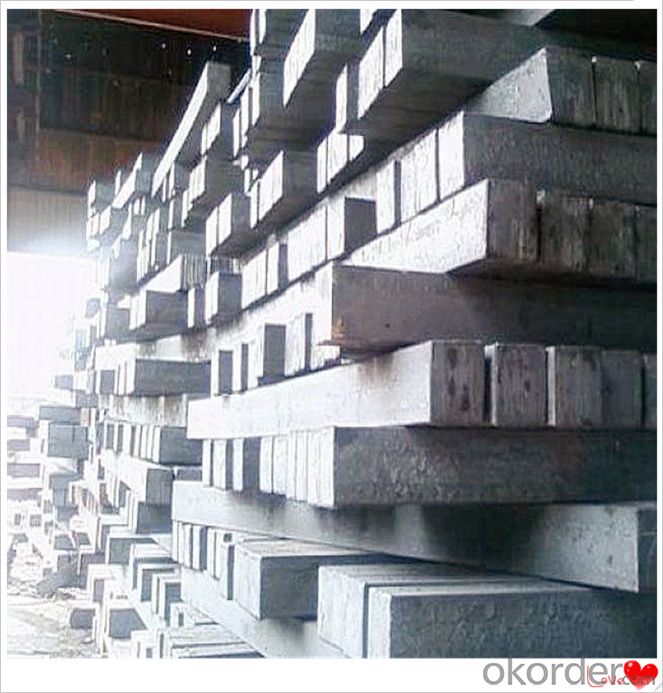
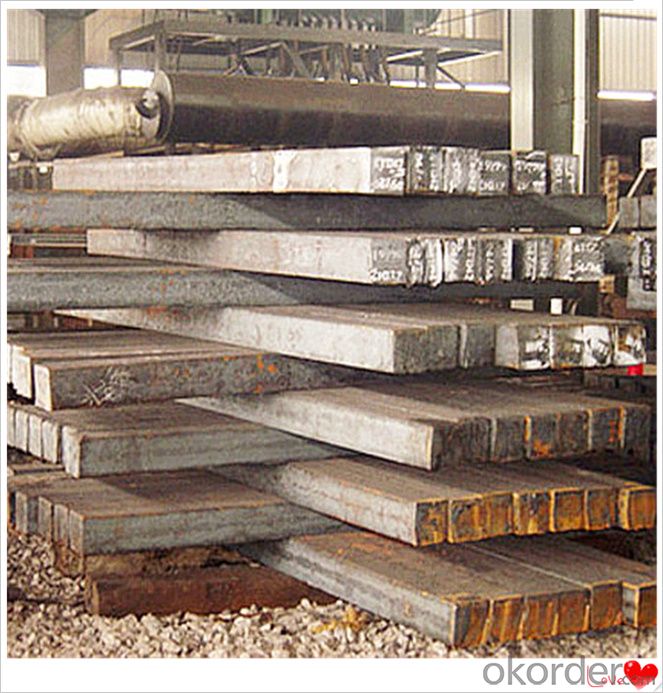
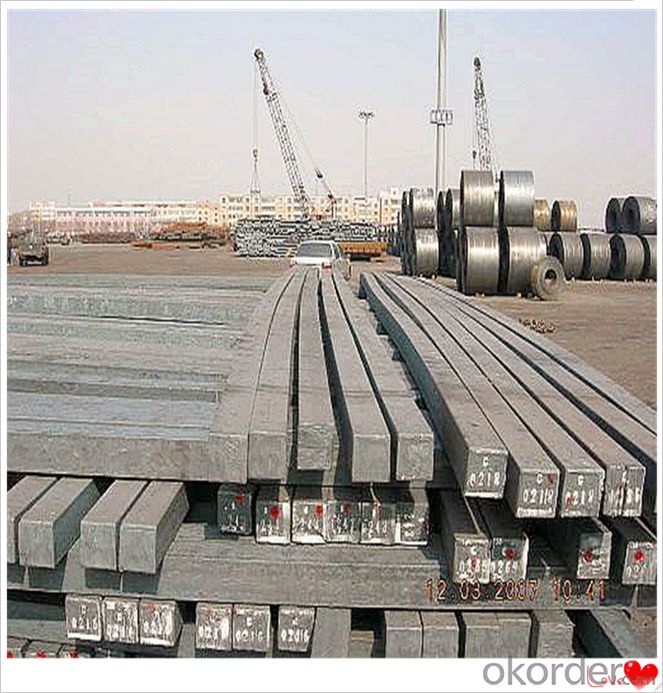
Processing
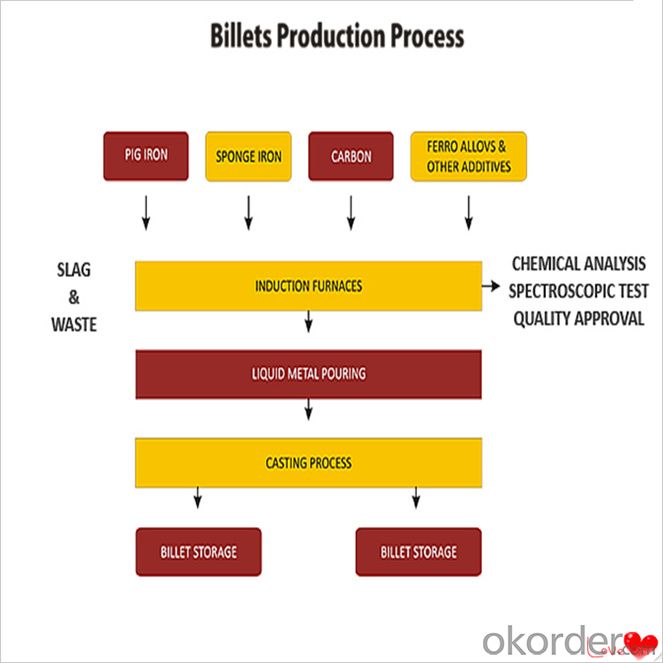
Usage-Billet Steel
Used for the plant, the bridge,shipment building high-rise building construction,lifting and transportation machinery, equipment manufracturing base building the support foundation pile manufacturing.
Billets, or ingots (as they sometimes referred to), are not of practical use until they have been formed into more functional shapes and sizes. While they have already been put in the furnace, they still require a series of shaping and molding procedures such as hot and cold working, milling and cutting before they are sold in hardware stores, or used for different applications. The unformed billets, however, can be used in striking currency such as coins and as reserves, similar to gold bars.
FAQ-Billet Steel
We have organized several common questions for our clients,may help you sincerely:
1) How about your company?
A world class manufacturer & supplier of castings forging in carbon steel and alloy steel,is one of the large-scale professional investment casting production bases in China,consisting of both casting foundry forging and machining factory. Annually more than 8000 tons Precision casting and forging parts are exported to markets in Europe,America and Japan. OEM casting and forging service available according to customer’s requirements.
2) How to guarantee the quality of the products?
We have established the international advanced quality management system,every link from raw material to final product we have strict quality test;We resolutely put an end to unqualified products flowing into the market. At the same time, we will provide necessary follow-up service assurance.
3) How long can we receive the product after purchase?
In the purchase of product within three working days, We will arrange the factory delivery as soon as possible. The pecific time of receiving is related to the state and position of customers.Commonly 7 to 10 working days can be served.
4)Do you have your own QC department?
Yes, we have, our QC department will inspect the goods during the process of mass production and after completion of production.
hot sale!!! Cast Steel Grades/ mild steel bar/ billet steel
(1): High quality steel with reasonable price.
(2): Wide excellent experiences with after-sale service.
(3): Every process will be checked by responsible QC which insures every product's quality.
(4): Professional packing teams which keep every packing safely.
(5): Trial order can be done in one week.
(6): Samples can be provided as your requirements.
- Q: What is the role of steel billets in the manufacturing of pressure vessels?
- Steel billets play a crucial role in the manufacturing of pressure vessels. Pressure vessels are designed to hold and contain fluids or gases at a higher pressure than the atmospheric pressure. These vessels are used in various industries such as oil and gas, chemical, pharmaceutical, and many more. The role of steel billets in the manufacturing process is to serve as the raw material for constructing the pressure vessel. Steel billets are semi-finished products that are obtained through the continuous casting or hot rolling of steel ingots. They have a rectangular or square cross-section and are typically made from carbon steel or alloy steel. Steel billets possess several key properties that make them ideal for pressure vessel manufacturing. Firstly, they have excellent strength and toughness, which is crucial for withstanding the high internal pressure exerted by the fluids or gases inside the vessel. This ensures the structural integrity and safety of the vessel. Secondly, steel billets have good weldability, which is essential for fabricating the pressure vessel. Welding is a common joining technique used in pressure vessel manufacturing, and the weld joints must have comparable strength to the base material. Steel billets allow for strong and reliable welds to be made during the fabrication process. Moreover, steel billets can be easily formed and shaped into the desired size and dimensions required for the pressure vessel. They can be forged, rolled, or extruded to create the necessary components of the vessel, such as the cylindrical body, heads, nozzles, and flanges. This versatility in shaping allows for customization based on the specific requirements of the pressure vessel. Furthermore, steel billets are known for their corrosion resistance, which is important for pressure vessels that come into contact with corrosive fluids or gases. The selection of the appropriate steel grade for the billets ensures that the pressure vessel can withstand the corrosive environment and maintain its integrity over time. In conclusion, steel billets are essential in the manufacturing of pressure vessels as they provide the raw material with the necessary properties to withstand high-pressure conditions. Their strength, weldability, formability, and corrosion resistance make them an ideal choice for constructing reliable and durable pressure vessels used in various industries.
- Q: How are steel billets inspected for surface finish?
- To ensure quality and compliance with industry standards, various methods and techniques are employed to inspect the surface finish of steel billets. Visual inspection is a common approach, where trained inspectors carefully examine the billet's surface for any defects, such as scratches, pits, cracks, or irregularities. This examination is typically conducted under appropriate lighting conditions to enhance defect visibility. Another method employed is non-destructive testing (NDT), which encompasses techniques like magnetic particle inspection (MPI) and liquid penetrant inspection (LPI). MPI involves the application of a magnetic field to the billet, followed by the use of a magnetic particle suspension to reveal surface defects by adhering to them. On the other hand, LPI involves the application of a liquid penetrant solution to the billet's surface, which is subsequently removed and followed by the application of a developer to highlight any defects. Ultrasonic testing (UT) is also commonly utilized to inspect the surface finish of steel billets. UT employs high-frequency sound waves transmitted through the billet, with any reflected waves analyzed to detect surface or subsurface defects. This method provides detailed information about the surface condition and can even detect minute flaws. Additionally, surface profilometers can be employed to measure the roughness of the billet's surface. These devices utilize a stylus or laser to measure height variations on the surface, thereby providing data on roughness and texture. In summary, a combination of visual inspection, NDT techniques, and surface profilometry is employed to conduct thorough inspections of steel billets' surface finish. These inspections play a crucial role in ensuring that the billets meet the required surface finish standards and are suitable for further processing or manufacturing.
- Q: What are the different types of steel billets used in the manufacturing industry?
- There are several different types of steel billets used in the manufacturing industry, including carbon steel billets, alloy steel billets, stainless steel billets, and tool steel billets. Each type of billet has its own unique composition and properties, making them suitable for various applications in industries such as construction, automotive, and aerospace.
- Q: Can steel billets be recycled?
- Yes, steel billets can be recycled. Steel is a highly recyclable material, and the recycling process involves melting down the steel billets to create new steel products, reducing the need for raw materials and conserving energy.
- Q: What is the role of steel billets in the production of steel bars?
- Steel billets have a crucial role in the production of steel bars, as they serve as semi-finished forms of steel typically cast in square or rectangular shapes. These billets are essential for creating various steel products, including steel bars. The main purpose of steel billets is to undergo further processing and transformation into steel bars through a series of manufacturing steps. After obtaining the steel billets, they undergo a process called hot rolling. This process involves subjecting the billets to high temperatures and passing them through rolling mills, which shape and elongate them into desired forms like round bars, square bars, or hexagonal bars. During the hot rolling process, the steel billets experience extreme heat and pressure, causing them to deform and elongate. This process improves the mechanical properties of the steel, such as strength, toughness, and ductility. Additionally, it refines the grain structure of the steel, enhancing its overall quality and performance. Steel bars produced from steel billets have wide applications in industries like construction, manufacturing, infrastructure, and automotive. They serve as structural components in buildings, bridges, and other infrastructure projects, as well as in the production of machinery, tools, and equipment. In summary, steel billets play a critical role in the production of steel bars. They act as the starting material for the manufacturing process and go through hot rolling to transform into desired shapes and sizes. The resulting steel bars find extensive use in various applications due to their improved mechanical properties and enhanced quality.
- Q: What are the main challenges in the supply chain management of steel billets?
- The main challenges in the supply chain management of steel billets include ensuring efficient transportation and logistics, managing inventory levels to avoid stockouts or excess inventory, dealing with fluctuating demand and production uncertainties, maintaining quality standards throughout the supply chain, and effectively collaborating with suppliers and customers to ensure timely delivery and customer satisfaction.
- Q: How are steel billets used in the production of structural components?
- Steel billets are used in the production of structural components by being heated and molded into desired shapes such as beams, columns, and plates. These billets serve as the starting material, which is then further processed through rolling, forging, or extrusion to create strong and durable structural components used in various industries such as construction, automotive, and aerospace.
- Q: Billet market trend
- 3, Tangshan billet inventory declineIt is understood that in April, the Tangshan region began to decline in the stock of major steel warehouse, as of April 28th, Tangshan billet inventory at about 1 million 250 thousand tons, a drop of about half higher than the high point. But some vendors have revealed that some of the resources are being transferred from the warehouse to the traders. In fact, inventories are much larger than statistics, and the inventory of 1 million 250 thousand tons of steel is about 2.5 times that of the same period of last year.In addition, network analyst China industry insight believes the macroeconomic situation, the weakening of steel and steel industry more negative news of the credit crisis will be unfavorable to the billet market outlook. But considering the steel production has been at a loss, the billet has a certain resilience; and before the May Day holiday billet prices fell rapidly, it is possible to pull up the opportunity to play after the manufacturers in a certain way.
- Q: How are steel billets used in the production of aerospace components?
- Steel billets are used in the production of aerospace components as they serve as the starting material for the manufacturing process. Steel billets are essentially semi-finished steel forms that are hot-rolled or forged into specific shapes and sizes. In the aerospace industry, steel billets are typically used to produce critical components such as landing gear, engine components, structural parts, and fasteners. These billets are chosen for their superior strength, durability, and resistance to high temperatures and corrosive environments, which are crucial properties required for aerospace applications. The production of aerospace components using steel billets involves several steps. First, the billets are heated to a high temperature to make them malleable and easy to work with. They are then subjected to various forming processes such as forging, extrusion, or rolling, which shape them into the desired form. These processes allow for precise shaping and dimensional accuracy, ensuring that the components meet the required specifications and tolerances. After the initial shaping, the aerospace components are subjected to further processes such as heat treatment, machining, and surface finishing to enhance their mechanical properties and improve their surface quality. Heat treatment processes such as quenching and tempering are used to strengthen the steel and improve its hardness, toughness, and resistance to wear and fatigue. Machining processes are then employed to achieve the final shape, size, and surface finish of the components. Once the components are manufactured, they undergo rigorous quality control procedures to ensure they meet the stringent standards and regulations of the aerospace industry. This includes thorough inspections, non-destructive testing, and material analysis to verify their integrity, performance, and safety. In summary, steel billets are essential in the production of aerospace components as they provide a reliable and strong starting material. The versatility and excellent mechanical properties of steel make it a preferred choice in the aerospace industry, where reliability and safety are of utmost importance.
- Q: How do steel billets contribute to the overall safety of a structure?
- Steel billets play a significant role in contributing to the overall safety of a structure in several ways. Firstly, steel billets serve as the raw material for manufacturing steel bars, beams, columns, and other structural components. These components are widely used in construction due to their high strength and durability. By using steel billets as the starting material, the resulting steel products exhibit excellent load-bearing capacity, which enhances the structural integrity of the building. Moreover, steel billets undergo a rigorous manufacturing process that includes various quality control checks. These checks ensure that the billets possess consistent and reliable mechanical properties, such as high tensile strength and impact resistance. As a result, when these billets are used in the construction of a structure, they contribute to its overall safety by providing a reliable and robust framework that can withstand external forces, such as wind, earthquakes, or heavy loads. Additionally, steel billets are often produced using advanced metallurgical techniques, such as controlled cooling or heat treatment, to achieve specific properties required for structural applications. These processes help in improving the microstructure of the steel, reducing internal defects, and enhancing its resistance to corrosion, fatigue, and other forms of degradation. This, in turn, increases the lifespan of the structure and minimizes the risk of structural failure, thus ensuring the safety of the occupants. Furthermore, steel billets can be manufactured with precise dimensions and tolerances, allowing for accurate and efficient construction. This precision in fabrication ensures that structural components fit together seamlessly, reducing the likelihood of gaps, misalignments, or weak points that could compromise the safety of the structure. Lastly, steel billets are highly recyclable, making them an environmentally friendly choice for construction. By opting for steel billets, the construction industry can reduce its carbon footprint and contribute to sustainable development. This focus on sustainability aligns with the overall safety of a structure, as a sustainable approach ensures the long-term stability and resilience of the built environment. In conclusion, steel billets contribute to the overall safety of a structure by providing high-strength, durable, and reliable materials for construction. Their consistent mechanical properties, resistance to external forces, improved microstructure, and precise fabrication ensure a strong and secure framework. Moreover, their recyclability promotes sustainability, further enhancing the long-term safety and integrity of the structure.
Send your message to us
Billet Brake Reservoir Q235,Q255,Q275,Q345,3SP,5SP,20MnSi
- Loading Port:
- China main port
- Payment Terms:
- TT OR LC
- Min Order Qty:
- 20 m.t.
- Supply Capability:
- 200000 m.t./month
OKorder Service Pledge
OKorder Financial Service
Similar products
Hot products
Hot Searches
Related keywords
